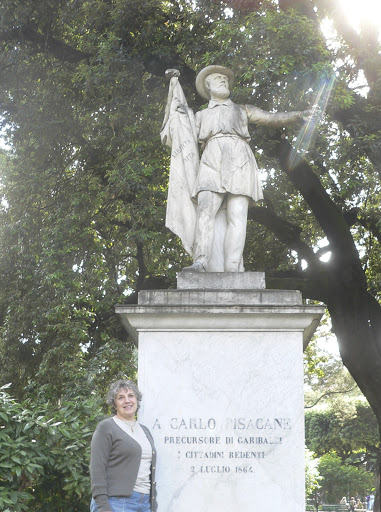Annamaria on Monday

I have not the slightest illusion that what I have experienced in my life comes anywhere near what of victims of racism and antisemitism have suffered at the hands of bullies and bigots. That they face still today, despite a great deal of hard work to the contrary. But I did experience bigotry in my early life, and the taste I had of it helps me find empathy and common cause with those other victims, whose portion has been far worse then mine - subjugation and violence.
I am fully aware that as a white person I have enjoyed unfair advantages over nonwhite people here in the "land of the free and the home of the brave." Crimes against what we now "call people of color" have been before my eyes all my life.
In a small way, in my small sphere of experience as a young child, I got the bigotry treatment. I was about the age you see in the photos above. Four years old. In those days, my extended family was my whole world. One of the most powerful people in it, my mother's oldest brother, held a deep-rooted prejudice against me. Why?
Statue to my ancestor, Carlo Pisacane in SalernoWell, you see, my mother's father, while living in an immigrant neighborhood in New Jersey, was a Neapolitan aristocrat, descendant of a baron and patriot, who is to Italian history what Patrick Henry was to the American Revolution. My mother, however, had chosen to marry a poor first generation American, the orphan of a Sicilian immigrant coal miner. Disgraceful! The distinction may seem trivial these days, but it was my parentage that led to my first experience of bigotry.
Do you wonder why my mom wasn't interested in someone from a "better" family?One day, my uncle - arriving for lunch with his mother - found me on the walkway next to the two-family house my parents shared with my grandparents. "Siggi!," he greeted me with a pejorative for a Sicilian. "You're a nigger," he said. "I don't think I am," I answered. He sneered. "There's nothing between Sicily and Africa but water," he said. He picked me up and rubbed his stubbly chin on my cheek. It was like sandpaper. I can still touch the spot that burned as he laughed and walked away.
It was not until years later that I realized that there is nothing between any part of the Italian coast and Africa but water. In fact, there is nothing between any coast in world and Africa, but water. I learned that by looking at the map in school.
School. The scene of my next runin with bigotry was Our Lady of Lourdes School, where the student body included all the varieties of Catholic kids, but predominantly Irish ones, most of whom were nice kids from nice families. But quite a few were bigoted bullies who called me and my ilk (regardless of where on the "boot" our families originated) "wops," dagos," and "eye-ties," usually preceded by "filthy," "dirty," or "greasy." Or all three. They beat us. They threw stuff at us.
I know this is not the same as being lynched. Italians were lynched years before, but that was in Louisiana, not in the New Jersey of my childhood.
One nun who taught me added to the picture. I asked her when I was nine, why every year a blonde girl was chosen to play the Blessed Mother in the Christmas tableau. "All the Jewish mommies and girls in my neighborhood look more like us Italians - dark haired." In response, that nun said these exact words to me. "God prefers the fair-haired peoples of the north." This was years after my father and my uncles on both sides of my family had fought, and in one case died defeating the "master race."
Add to this the fact that my family was poor. I don't mean that we were not rich. Poor, as in I wore my older brother's hand-me-downs. Poor, as in there was not enough money for shoes.
Oh, I am not asking you to feel sorry for me. Just to believe me when I say that the economic subjugation of people of color, in the US - and the rest of the world, for that matter, multiplies the effects of bigotry. Poverty is humiliating. Racism tells people they are less than human. The combination the two is a kind of psychological violence. It's putting society's knee on a person's soul and keeping it there until their spirit dies. It's a crime. And one for which you can't call the cops.
The Cops! Well, I wrote a blog here four years and a few weeks ago, called Bad Policing and Me. It tells my first-hand knowledge of bullying and racism on the part of the police.
In no way do I believe that all policemen are as evil as ones in my stories in the 2016 blog. Many of us mystery novelists write stories in which the main characters are policeman, doing their jobs well. What I cannot fathom is how the good cops, who everyone says are the majority, can tolerate the "bad apples" in their midst. Why are they not siding with the public and purging their ranks of the bigots, bullies, and incompetents who are giving them all a bad name and causing the citizenry that pays their salaries to rise up against them? It is incomprehensible.































































